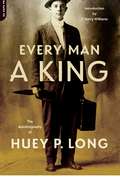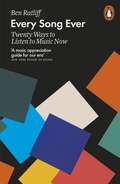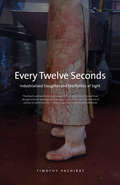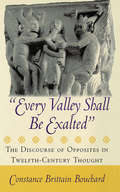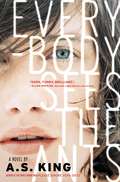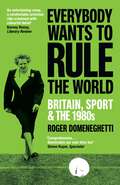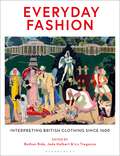- Table View
- List View
Every Man A King: The Autobiography Of Huey P. Long
by Huey P. LongHuey Long (1893-1935) was one of the most extraordinary American politicians, simultaneously cursed as a dictator and applauded as a benefactor of the masses. A product of the poor north Louisiana hills, he was elected governor of Louisiana in 1928, and proceeded to subjugate the powerful state political hierarchy after narrowly defeating an impeachment attempt. The only Southern popular leader who truly delivered on his promises, he increased the miles of paved roads and number of bridges in Louisiana tenfold and established free night schools and state hospitals, meeting the huge costs by taxing corporations and issuing bonds. Soon Long had become the absolute ruler of the state, in the process lifting Louisiana from near feudalism into the modern world almost overnight, and inspiring poor whites of the South to a vision of a better life. As Louisiana Senator and one of Roosevelt's most vociferous critics, "The Kingfish," as he called himself, gained a nationwide following, forcing Roosevelt to turn his New Deal significantly to the left. But before he could progress farther, he was assassinated in Baton Rouge in 1935. Long's ultimate ambition, of course, was the presidency, and it was doubtless with this goal in mind that he wrote this spirited and fascinating account of his life, an autobiography every bit as daring and controversial as was The Kingfish himself.
Every Nation Has Its Dish: Black Bodies and Black Food in Twentieth-Century America
by Jennifer Jensen WallachJennifer Jensen Wallach's nuanced history of black foodways across the twentieth century challenges traditional narratives of "soul food" as a singular style of historical African American cuisine. Wallach investigates the experiences and diverse convictions of several generations of African American activists, ranging from Booker T. Washington and W. E. B. Du Bois to Mary Church Terrell, Elijah Muhammad, and Dick Gregory. While differing widely in their approaches to diet and eating, they uniformly made the cultivation of "proper" food habits a significant dimension of their work and their conceptions of racial and national belonging. Tracing their quests for literal sustenance brings together the race, food, and intellectual histories of America.Directly linking black political activism to both material and philosophical practices around food, Wallach frames black identity as a bodily practice, something that conscientious eaters not only thought about but also did through rituals and performances of food preparation, consumption, and digestion. The process of choosing what and how to eat, Wallach argues, played a crucial role in the project of finding one's place as an individual, as an African American, and as a citizen.
Every Rising Sun: For a thousand and one nights Shaherazade told stories. This is hers.
by Jamila AhmedBefore she was the legendary Persian queen who spun a thousand tales, Shaherazade was a girl who saw something she shouldn't have.She told the king.She thought she was doing what was right.She couldn't have imagined what was to come.The Seljuk Empire is on fire and the king is on a rampage after learning of his wife's infidelity. Unsated by her execution, he has gone on to wed and behead a new wife night after night. Fear spreads through the city and Shaherazade must do something, anything, to halt the horror she has set in motion. When the king starts searching for his next bride, Shaherazade steps forward.As the sun sets on her wedding night, she begins to weave a tale that will go down in history.'A sumptuous, moreish novel infused with the joys of storytelling' LEILA ABOULELA, author of Minaret'I was entranced by this marvel of a book, wound about by the weave of its tales, unable to put it down' CLAIRE GILBERT, author of I, Julian
Every Song Ever: Twenty Ways to Listen to Music Now
by Ben RatliffFrom one of America's celebrated critics, the definitive field guide to listening to music in the age of the CloudThe most significant revolution in the recent history of music has to do with listening: it is now possible to listen to nearly anything at any time, to ignore albums, and to instantly flit across genres and generations, from 1980s Detroit techno to 1890s Viennese neo-romanticism. Yet music criticism has historically focused on the musician's intent, not the listener's experience. Every Song Ever is therefore the definitive field guide to listening in an age of glorious, overwhelming abundance. By revealing the essential similarities between wildly different kinds of music, Ben Ratliff shows how we listen to music now, and suggests how we can listen better.
Every Twelve Seconds: Industrialized Slaughter and the Politics of Sight (Yale Agrarian Studies Series)
by Timothy PachiratThis is an account of industrialized killing from a participant’s point of view. The author, political scientist Timothy Pachirat, was employed undercover for five months in a Great Plains slaughterhouse where 2,500 cattle were killed per day—one every twelve seconds. Working in the cooler as a liver hanger, in the chutes as a cattle driver, and on the kill floor as a food-safety quality-control worker, Pachirat experienced firsthand the realities of the work of killing in modern society. He uses those experiences to explore not only the slaughter industry but also how, as a society, we facilitate violent labor and hide away that which is too repugnant to contemplate. Through his vivid narrative and ethnographic approach, Pachirat brings to life massive, routine killing from the perspective of those who take part in it. He shows how surveillance and sequestration operate within the slaughterhouse and in its interactions with the community at large. He also considers how society is organized to distance and hide uncomfortable realities from view. With much to say about issues ranging from the sociology of violence and modern food production to animal rights and welfare, Every Twelve Seconds is an important and disturbing work.
"Every Valley Shall Be Exalted": The Discourse of Opposites in Twelfth-Century Thought
by Constance Brittain BouchardIn high medieval France, men and women saw the world around them as the product of tensions between opposites. Imbued with a Christian culture in which a penniless preacher was also the King of Kings and the last were expected to be first, twelfth-century thinkers brought order to their lives through the creation of opposing categories. In a highly original work, Constance Brittain Bouchard examines this poorly understood component of twelfth-century thought, one responsible, in her view, for the fundamental strangeness of that culture to modern thinking.Scholars have long recognized that dialectical reasoning was the basic approach to philosophical, legal, and theological matters in the high Middle Ages. Bouchard argues that this way of thinking and categorizing—which she terms a "discourse of opposites"—permeated all aspects of medieval thought. She rejects suggestions that it was the result of imprecision, and provides evidence that people of that era sought not to reconcile opposing categories but rather to maintain them.Bouchard scrutinizes the medieval use of opposites in five broad areas: scholasticism, romance, legal disputes, conversion, and the construction of gender. Drawing on research in a series of previously unedited charters and the earliest glossa manuscripts, she demonstrates that this method of constructing reality was a constitutive element of the thought of the period.
Everybody Ought to Be Rich: The Life and Times of John J. Raskob, Capitalist
by David FarberToday, consumer credit, employee stock options, and citizen investment in the stock market are taken for granted--fundamental facts of American economic life. But few people realize that they were first widely promoted by John Jakob Raskob (1879-1950), the innovative financier and self-made businessman who built the Empire State building, made millions for DuPont and General Motors, and helped shape the contours of modern capitalism. David Farber's Everybody Ought to Be Rich is the first biography of Raskob, a man who shunned the limelight (he was the anti-Trump of his time) but whose impact on free market enterprise can hardly be overstated. A colorful figure, Raskob's life evokes the roaring twenties, the Catholic elite, the boardrooms of America's biggest corporations, and the rags-to-riches tale that is central to the American dream. Farber follows Raskob's remarkable trajectory from a teenage candy seller on the railway between Lockport and Buffalo to the pinnacles of wealth and power. With no formal education but possessed of a boundless energy and an unshakeable faith in individual initiative (his motto was "Go ahead and do something!"), Raskob partnered with great industrialists and financiers, buying up companies, leveraging investments, reorganizing corporations, funneling money into the political system, and creating new pools of credit for rich investors and middle class consumers alike--practices commonplace today but revolutionary at the time. His most famous innovation was mass consumer credit, which he offered to individual car buyers, enabling working and middle-class Americans to purchase GM's more expensive cars. Raskob desperately wanted to bridge class divides and to share the wealth American corporations were fast creating--so that everyone could be rich. Chronicling Raskob's short-comings as well as his successes, Everybody Ought to Be Rich illuminates a crucial but little-known figure in American capitalism whose influence can still be felt today.
Everybody Ought to Be Rich: The Life and Times of John J. Raskob, Capitalist
by David FarberToday, consumer credit, employee stock options, and citizen investment in the stock market are taken for granted--fundamental facts of American economic life. But few people realize that they were first widely promoted by John Jakob Raskob (1879-1950), the innovative financier and self-made businessman who built the Empire State building, made millions for DuPont and General Motors, and helped shape the contours of modern capitalism. David Farber's Everybody Ought to Be Rich is the first biography of Raskob, a man who shunned the limelight (he was the anti-Trump of his time) but whose impact on free market enterprise can hardly be overstated. A colorful figure, Raskob's life evokes the roaring twenties, the Catholic elite, the boardrooms of America's biggest corporations, and the rags-to-riches tale that is central to the American dream. Farber follows Raskob's remarkable trajectory from a teenage candy seller on the railway between Lockport and Buffalo to the pinnacles of wealth and power. With no formal education but possessed of a boundless energy and an unshakeable faith in individual initiative (his motto was "Go ahead and do something!"), Raskob partnered with great industrialists and financiers, buying up companies, leveraging investments, reorganizing corporations, funneling money into the political system, and creating new pools of credit for rich investors and middle class consumers alike--practices commonplace today but revolutionary at the time. His most famous innovation was mass consumer credit, which he offered to individual car buyers, enabling working and middle-class Americans to purchase GM's more expensive cars. Raskob desperately wanted to bridge class divides and to share the wealth American corporations were fast creating--so that everyone could be rich. Chronicling Raskob's short-comings as well as his successes, Everybody Ought to Be Rich illuminates a crucial but little-known figure in American capitalism whose influence can still be felt today.
Everybody Sees the Ants
by A. S. KingLucky Linderman didn't ask for his life. He didn't ask his grandfather not to come home from the Vietnam War. He didn't ask for a father who never got over it. He didn't ask for a mother who keeps pretending their dysfunctional family is fine. And he didn't ask to be the target of Nader McMillan's relentless bullying, which has finally gone too far. But Lucky has a secret--one that helps him wade through the daily mundane torture of his life. In his dreams, Lucky escapes to the war-ridden jungles of Laos--the prison his grandfather couldn't escape--where Lucky can be a real man, an adventurer, and a hero. It's dangerous and wild, and it's a place where his life just might be worth living. But how long can Lucky keep hiding in his dreams before reality forces its way inside? Michael L. Printz Honor recipient A.S. King's smart, funny and boldly original writing shines in this powerful novel about learning to cope with the shrapnel life throws at you and taking a stand against it.
EveryBody Tells A Story: Zur Geschichte von Sport-, Körper- und Bewegungskulturen (Angewandte Forschung im Sport)
Der Titel des Buches ist in mehrfacher Hinsicht doppeldeutig. Der Sammelband vereint somatische, kulturhistorische und methodologische Themen. Aus der Perspektive der Sportgeschichtsschreibung als Kulturgeschichte von Körper, Bewegung und Sport werden Sinnkonstruktionen und Wirklichkeitsdeutungen der Menschen in Vergangenheit und Gegenwart beleuchtet. Vielfältige internationale Zugänge und Inhalte werden miteinander in Dialog gebracht, um die Sportgeschichte innovativ zu beleben und fortzuschreiben.
Everybody Wants to Rule the World: Britain, Sport and the 1980s
by Roger DomeneghettiA social history of 1980s Britain, told through the sport of the time.Travel back to the 1980s - to Botham's Ashes and the Brixton riots; the Moscow Olympics and the miners' strike; the Crucible Theatre and the Falklands - to explore how we got to where we are now. Discover how sport became fully entwined in our national story; how sporting heroes were made, and destroyed; how 'wars' were fought on the pitch; and how sport responded to - and drove cultural change in - our society.From Sebastian Coe to Margaret Thatcher, John Barnes to the ZX Spectrum, Martina Navratilova to Section 28, Everybody Wants to Rule the World speaks to our treasured memories of eighties sports while also throwing light on where things went deeply wrong. In so doing it tells nothing less than the story of how British sport came into the modern era.
Everybody’s Friend
by Raghu Karnad Clara WomersleyRaghu Karnad’s “Everybody’s Friend” is a poignant pilgrimage to the military grave of a great-uncle, fallen defending the obsolescent Raj against the oncoming army of imperial Japan. The most brutal fighting unfolded on the unforgiving northeast Indian border with Burma, and Karnad takes himself and the reader deep into Nagaland to find the war graves of Imphal. There he broods without heavy reproach but with stoical sorrow on the marginalisation of memory offered to Indian troops who, in the authorised epic of Indian independence, fought on the “wrong” side for their imperial masters while the much thinner ranks of the Indian National Army, Subhash Chandra Bose’s fighters, have been accorded the rites and respects of freedom fighters
Everybody's War: The Politics of Aid in the Syria Crisis
by Jehan Bseiso, Michiel Hofman and Jonathan WhittallThe Syrian crisis is one of the most serious humanitarian disasters in recent history. Yet the widely reported numbers--more than 6 million displaced, including 5 million refugees--reflect only a fractional toll of the conflict. Numerous international organizations, states, and civil society movements have called for the laws of war to be respected, sieges lifted, and humanitarian access facilitated. But beneath each of these humanitarian appeals lies a complicated reality extending beyond the binary narratives that have come to define the war in Syria. Everybody's War examines the complexities of humanitarianism in Syria and the wide-ranging consequences for both Syria's populations and humanitarian responses to future conflicts. Organized by Médecins Sans Frontières, this edited volume brings together academics and humanitarian practitioners from across the globe to provide a multitude of perspectives on the politics of aid in the Syrian war. Contributors explore the humanitarian crisis behind the Syrian conflict through the history and fragmentation of Syrian health care, the role of international humanitarian law in enabling attacks on health facilities, and the lived experience of siege in all its layers. Further attention is given to the ways in which humanitarian actors have fed the war economy and joined the information wars that have raged throughout the region over the past ten years. While the Syrian crisis has been everybody's war, it has certainly not been everybody's victory. This volume shares the intricate story of aid delivery and humanitarian complicity within one of the defining conflicts of the twenty-first century.
Everybody's War: The Politics of Aid in the Syria Crisis
The Syrian crisis is one of the most serious humanitarian disasters in recent history. Yet the widely reported numbers--more than 6 million displaced, including 5 million refugees--reflect only a fractional toll of the conflict. Numerous international organizations, states, and civil society movements have called for the laws of war to be respected, sieges lifted, and humanitarian access facilitated. But beneath each of these humanitarian appeals lies a complicated reality extending beyond the binary narratives that have come to define the war in Syria. Everybody's War examines the complexities of humanitarianism in Syria and the wide-ranging consequences for both Syria's populations and humanitarian responses to future conflicts. Organized by Médecins Sans Frontières, this edited volume brings together academics and humanitarian practitioners from across the globe to provide a multitude of perspectives on the politics of aid in the Syrian war. Contributors explore the humanitarian crisis behind the Syrian conflict through the history and fragmentation of Syrian health care, the role of international humanitarian law in enabling attacks on health facilities, and the lived experience of siege in all its layers. Further attention is given to the ways in which humanitarian actors have fed the war economy and joined the information wars that have raged throughout the region over the past ten years. While the Syrian crisis has been everybody's war, it has certainly not been everybody's victory. This volume shares the intricate story of aid delivery and humanitarian complicity within one of the defining conflicts of the twenty-first century.
Everyday Acts of Design: Learning in a Time of Emergency (Designing in Dark Times)
by Zoy Anastassakis Marcos MartinsFrom 2016-2018, teachers and students at the State University of Rio de Janeiro in Brazil found themselves at the center of a crisis. A new right-wing government suspended payment of staff salaries and student scholarships and stopped funding basic maintenance. Everyday Acts of Design tells the story of how the university's design school reacted to the crisis: not with despondency or despair, but by promoting a series of radical teaching experiments.Working together, students, alumni, teachers, and staff embraced hope as a method, demonstrating that it is possible to find positive answers even in a situation of imminent collapse. The case histories narrated in the book provide alternatives to conventional forms of design teaching, but also prove that education can be a site for democracy and the practice of freedom. Deprived of the activity of creating for an imagined future, design can still assert a way forward through practices of making and experimenting. Drawing on their personal experience of designing and teaching design at a time of crisis, the authors assert the value of a design attitude which, in refusing to be delimited by the forethought of designing, insists on a radical, experimental practice as a means of survival.Although a multitude of voices, both assenting and dissenting, are present in the text, the authors do not hide their own position, making it clear that their stories are not a balanced mosaic of polyphonic positions. The contemporary attack on free public education, fueled by the growth of far-right regimes all over the globe, relies on a totalizing univocal conception of 'truth' as a means to shut down a plurality of thinking. Against this, this book adopts the partiality of historical and cultural truths as an urgent and explicit counter-attack. Adopting a consciously international approach,the authors connect and compare their own story with those of similar design teaching movements in the Global South, such as the Barefoot School in India, and ZIVA, founded by Saki Mafunkikwa in Zimbabwe.
Everyday Acts of Design: Learning in a Time of Emergency (Designing in Dark Times)
by Zoy Anastassakis Marcos MartinsFrom 2016-2018, teachers and students at the State University of Rio de Janeiro in Brazil found themselves at the center of a crisis. A new right-wing government suspended payment of staff salaries and student scholarships and stopped funding basic maintenance. Everyday Acts of Design tells the story of how the university's design school reacted to the crisis: not with despondency or despair, but by promoting a series of radical teaching experiments.Working together, students, alumni, teachers, and staff embraced hope as a method, demonstrating that it is possible to find positive answers even in a situation of imminent collapse. The case histories narrated in the book provide alternatives to conventional forms of design teaching, but also prove that education can be a site for democracy and the practice of freedom. Deprived of the activity of creating for an imagined future, design can still assert a way forward through practices of making and experimenting. Drawing on their personal experience of designing and teaching design at a time of crisis, the authors assert the value of a design attitude which, in refusing to be delimited by the forethought of designing, insists on a radical, experimental practice as a means of survival.Although a multitude of voices, both assenting and dissenting, are present in the text, the authors do not hide their own position, making it clear that their stories are not a balanced mosaic of polyphonic positions. The contemporary attack on free public education, fueled by the growth of far-right regimes all over the globe, relies on a totalizing univocal conception of 'truth' as a means to shut down a plurality of thinking. Against this, this book adopts the partiality of historical and cultural truths as an urgent and explicit counter-attack. Adopting a consciously international approach,the authors connect and compare their own story with those of similar design teaching movements in the Global South, such as the Barefoot School in India, and ZIVA, founded by Saki Mafunkikwa in Zimbabwe.
The Everyday Cold War: Britain and China, 1950-1972
by Chi-Kwan MarkIn 1950 the British government accorded diplomatic recognition to the newly founded People's Republic of China. But it took 22 years for Britain to establish full diplomatic relations with China. How far was Britain's China policy a failure until 1972? This book argues that Britain and China were involved in the 'everyday Cold War', or a continuous process of contestation and cooperation that allowed them to 'normalize' their confrontation in the absence of full diplomatic relations. From Vietnam and Taiwan to the mainland and Hong Kong, China's 'everyday Cold War' against Britain was marked by diplomatic ritual, propaganda rhetoric and symbolic gestures. Rather than pursuing a failed policy of 'appeasement', British decision-makers and diplomats regarded engagement or negotiation with China as the best way of fighting the 'everyday Cold War'.Based on extensive British and Chinese archival sources, this book examines not only the high politics of Anglo-Chinese relations, but also how the British diplomats experienced the Cold War at the local level.
The Everyday Cold War: Britain and China, 1950-1972
by Chi-Kwan MarkIn 1950 the British government accorded diplomatic recognition to the newly founded People's Republic of China. But it took 22 years for Britain to establish full diplomatic relations with China. How far was Britain's China policy a failure until 1972? This book argues that Britain and China were involved in the 'everyday Cold War', or a continuous process of contestation and cooperation that allowed them to 'normalize' their confrontation in the absence of full diplomatic relations. From Vietnam and Taiwan to the mainland and Hong Kong, China's 'everyday Cold War' against Britain was marked by diplomatic ritual, propaganda rhetoric and symbolic gestures. Rather than pursuing a failed policy of 'appeasement', British decision-makers and diplomats regarded engagement or negotiation with China as the best way of fighting the 'everyday Cold War'.Based on extensive British and Chinese archival sources, this book examines not only the high politics of Anglo-Chinese relations, but also how the British diplomats experienced the Cold War at the local level.
Everyday Communists in South Africa’s Liberation Struggle: The Lives of Ivan and Lesley Schermbrucker (Palgrave Studies in the History of Social Movements)
by Alan KirkaldyThis book explores the role of social movements in the Southern African liberation struggle, through the lens of two ‘everyday communists’. Focusing on the Communist Party of South Africa (CPSA), the author explores the lives of Ivan and Lesley Schermbrucker, whose contribution to the party was more clandestine than that of leaders such as Bram Fischer and Joe Slovo. They represent how ‘ordinary’ people could play significant roles based on stances more rooted in common decency and morality than in Marxist theory. The book also sheds light on the interplay between transnational and national tendencies during the liberation movement, particularly between the 1940s and the 1960s. The Schermbruckers changed their views in response to the shifting national and international political landscape, the rise of Stalinism, and the flight of South African activists into exile from the 1960s. Both fluent in African languages, they were able to create relationships of trust with African members of the CPSA. Examining tensions and conflicts during the liberation struggle, this book provides fresh insights into ‘underground’ activism.
Everyday Examples: An Introduction to Philosophy
by David Cunning"Free will: mental energy that poofs into existence from scratch?"In pairing key ideas from the history of philosophy with examples from everyday life and culture, David Cunning produces a clear, incisive and engaging introduction to philosophy. Everyday Examples explores historical philosophy and the contemporary theory scene and includes ideas from both the analytic and continental traditions. This broad sweep of topics provides a synoptic overview of philosophy as a discipline and philosophizing as an activity.With examples drawn from everything from The Matrix and Sesame Street to sleepwalking, driving, dancing, playing a sport and observing animals, students are pointed to ways in which they can be a philosopher outside the classroom in the everyday world.As well as providing entertaining and relatable examples from everyday life, this book will be especially useful in the classroom, it is accessible and discussion-oriented, so that students can get first-hand practice at actually 'doing' philosophy. This accessibility does not come at the expense of rigour but, rather, provides a 'way in' to thinking about the major issues, figures and moments in the history of philosophy. The chapters are divided into brief sustainable nuggets so that students can get a definite handle on each issue and also be the expert for the day on a given section.There are suggested study questions at the end of each chapter that bring out the force of each side of the many different issues.An indispensable tool for those approaching philosophy for the first time.
Everyday Examples: An Introduction to Philosophy
by David Cunning"Free will: mental energy that poofs into existence from scratch?"In pairing key ideas from the history of philosophy with examples from everyday life and culture, David Cunning produces a clear, incisive and engaging introduction to philosophy. Everyday Examples explores historical philosophy and the contemporary theory scene and includes ideas from both the analytic and continental traditions. This broad sweep of topics provides a synoptic overview of philosophy as a discipline and philosophizing as an activity.With examples drawn from everything from The Matrix and Sesame Street to sleepwalking, driving, dancing, playing a sport and observing animals, students are pointed to ways in which they can be a philosopher outside the classroom in the everyday world.As well as providing entertaining and relatable examples from everyday life, this book will be especially useful in the classroom, it is accessible and discussion-oriented, so that students can get first-hand practice at actually 'doing' philosophy. This accessibility does not come at the expense of rigour but, rather, provides a 'way in' to thinking about the major issues, figures and moments in the history of philosophy. The chapters are divided into brief sustainable nuggets so that students can get a definite handle on each issue and also be the expert for the day on a given section.There are suggested study questions at the end of each chapter that bring out the force of each side of the many different issues.An indispensable tool for those approaching philosophy for the first time.
Everyday Fashion: Interpreting British Clothing Since 1600
by Bethan Bide, Jade Halbert and Liz TregenzaOrdinary clothes have extraordinary stories. In contrast to academic and curatorial focus on the spectacular and the luxurious, Everyday Fashion makes the case that your grandmother's wardrobe is an archive as interesting and important as any museum store. From the moment we wake and get dressed in the morning until we get undressed again in the evening, fashion is a central medium through which we experience the world and negotiate our place within it. Because of this, the ways that supposedly 'ordinary' and 'everyday' fashion objects have been designed, manufactured, worn, cared for, and remembered matters deeply to our historical understanding.Beginning at 1550 – the start of an era during which the word 'fashion' came to mean stylistic change rather than the act of making – each chapter explores the definition of everyday fashion and how this has changed over time, demonstrating innovative methodologies for researching the everyday. The variety and significance of everyday fashion cultures are further highlighted by a series of illustrated object biographies written by Britain's leading fashion curators, showcasing the rich diversity of everyday fashion in British museum collections. Collectively, this volume scratches below the glossy surface of fashion to expose the mechanics of fashion business, the hidden world of the workroom and the diversity and role of makers; and the experiences of consuming, wearing, and caring for ordinary clothes in the United Kingdom from the 16th century to the present day. In doing so it challenges readers to rethink how fashion systems evolve and to reassess the boundaries between fashion and dress scholarship.
Everyday Fashion: Interpreting British Clothing Since 1600
Ordinary clothes have extraordinary stories. In contrast to academic and curatorial focus on the spectacular and the luxurious, Everyday Fashion makes the case that your grandmother's wardrobe is an archive as interesting and important as any museum store. From the moment we wake and get dressed in the morning until we get undressed again in the evening, fashion is a central medium through which we experience the world and negotiate our place within it. Because of this, the ways that supposedly 'ordinary' and 'everyday' fashion objects have been designed, manufactured, worn, cared for, and remembered matters deeply to our historical understanding.Beginning at 1550 – the start of an era during which the word 'fashion' came to mean stylistic change rather than the act of making – each chapter explores the definition of everyday fashion and how this has changed over time, demonstrating innovative methodologies for researching the everyday. The variety and significance of everyday fashion cultures are further highlighted by a series of illustrated object biographies written by Britain's leading fashion curators, showcasing the rich diversity of everyday fashion in British museum collections. Collectively, this volume scratches below the glossy surface of fashion to expose the mechanics of fashion business, the hidden world of the workroom and the diversity and role of makers; and the experiences of consuming, wearing, and caring for ordinary clothes in the United Kingdom from the 16th century to the present day. In doing so it challenges readers to rethink how fashion systems evolve and to reassess the boundaries between fashion and dress scholarship.
Everyday Fashion in Found Photographs: American Women of the Late 19th Century
by Lisa HodgkinsIn the last half of the 19th century, the women of America were beginning to develop their own sense of style. Although influenced by European fashions and the social and economic changes of the time, they made clothing choices based upon their personal aspirations and their practical everyday needs. Providing an overview of fashion influences for each decade from the 1860s to the end of the century, Everyday Fashion in Found Photographs presents iconic garments, using sources from the period, to provide commentary and detailed description of the styles of the time. Previously unpublished vintage photographs show women across the social spectrum wearing items such as the Garibaldi shirt, the cuirass bodice, the Mother Hubbard, bicycle bloomers, and much more. Names, dates and functions of garments are examined in detail, and ties are established between social and historical contexts and the evolution of clothing styles.This illustrated book is for readers who want to identify and understand specific clothing items as well as gain insight into the mind-set of fashionable women from Victorian-era America. Dress history scholars, costume designers, curators of costume collections, social and cultural historians and those who appreciate vintage photographs can learn about elements of late 19th century women's dress and thereby develop an understanding of what was fashionable, and why.
Everyday Fashion in Found Photographs: American Women of the Late 19th Century
by Lisa HodgkinsIn the last half of the 19th century, the women of America were beginning to develop their own sense of style. Although influenced by European fashions and the social and economic changes of the time, they made clothing choices based upon their personal aspirations and their practical everyday needs. Providing an overview of fashion influences for each decade from the 1860s to the end of the century, Everyday Fashion in Found Photographs presents iconic garments, using sources from the period, to provide commentary and detailed description of the styles of the time. Previously unpublished vintage photographs show women across the social spectrum wearing items such as the Garibaldi shirt, the cuirass bodice, the Mother Hubbard, bicycle bloomers, and much more. Names, dates and functions of garments are examined in detail, and ties are established between social and historical contexts and the evolution of clothing styles.This illustrated book is for readers who want to identify and understand specific clothing items as well as gain insight into the mind-set of fashionable women from Victorian-era America. Dress history scholars, costume designers, curators of costume collections, social and cultural historians and those who appreciate vintage photographs can learn about elements of late 19th century women's dress and thereby develop an understanding of what was fashionable, and why.
